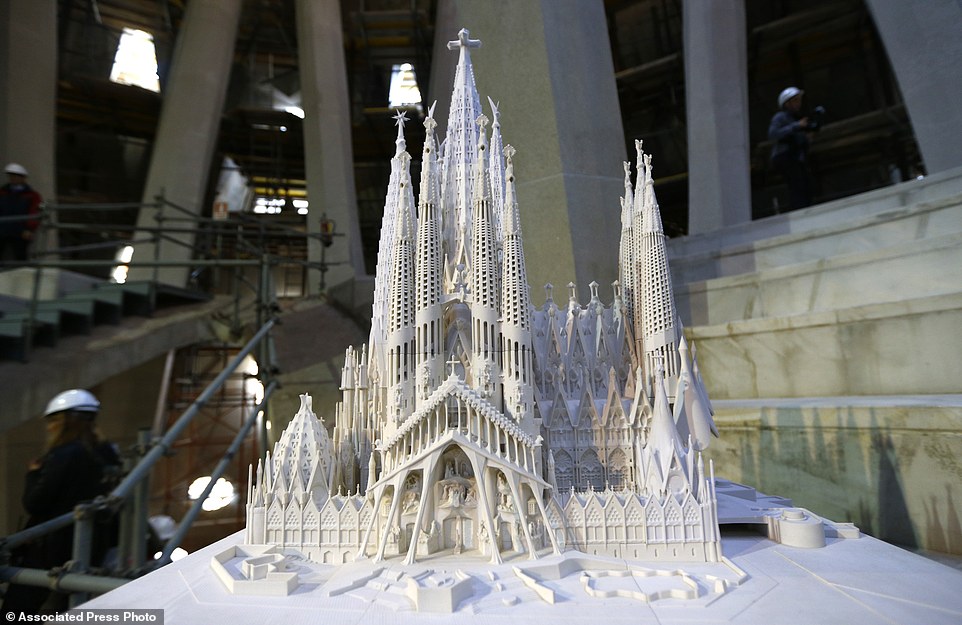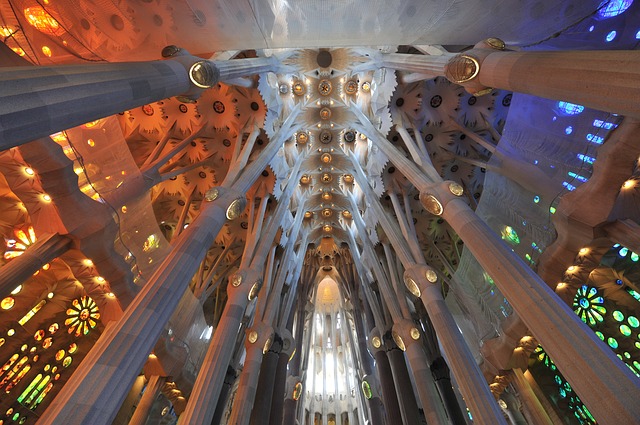Sagrada Familia
Contents |
[edit] Introduction
The Sagrada Familia is a monumental Roman Catholic church in Barcelona, Spain. It was designed by the architect Antoni Gaudi. Construction work has been ongoing, intermittently, since 1882, and it is perhaps the most famous incomplete building in the world. It is listed as a UNESCO World Heritage Site and is an iconic symbol of Spain.
The Spiritual Association of Devotees of Saint Joseph was founded in 1874, and began campaigning for the construction of an expiatory temple dedicated to the Holy Family. The Association purchased a plot of land in Barcelona and the first stone was laid on St. Joseph’s Day, March 1882.
Gaudi became involved a year later and transformed the original neo-gothic design into his trademark style, combining elements of gothic and byzantine cathedrals, and curvilinear Art Nouveau forms. Gaudi continued to work on the project until his death in 1926, when less than a quarter of his grand vision had been realised.
Today, the Sagrada Familia is one of the largest testing grounds for construction methods in the world, and one of Spain’s most popular tourist attractions, with visitor entrance fees financing the annual construction budget of around 25 million euros.
[edit] Design and construction
Gaudi wanted to express Christian belief through the architecture of the cathedral, and to capture the essence of transcendence with the lofty forms, geometry and the interplay of light and colour. His original design consisted of 18 towers, each with its own significance. The central tower would be dedicated to Jesus Christ and was intended to reach 172 m in height.
The temple is made up of a central nave flanked by aisles and transepts forming a Latin cross. At the head of the cross is a semi-circular apse. Three monumental facades represent Christ’s birth, his Passion, Death and Resurrection, and future Glory.
A model of Gaudi's finished design:
Knowing he would not be alive to see the temple completed, Gaudi planned the construction in modules, starting with the apse and first façade. Seeking to overcome traditional Gothic structural systems, Gaudi began experimenting with balanced and self-supporting structures using inverted models and graphical calculation. He was inspired by the idea of a 'forest' structure of leaning columns that would branch out like trees, and create an organised and hierarchical system to support a light and airy vault.
Some of the structural forms Gaudi introduced to the Sagrada Familia include:
- Hyperboloids: These can be solid or hollow, and found in the openings of the windows and the vaults.
- Paraboloids: To create linking surfaces between the vaults, the roof and the columns.
- Helicoids: These can be seen in the spiral staircases and were, Gaudi said, to represent the rising movement of transcendence.
- Ellipsoids: These form the rounded capitals of the main columns, where the lower sections subdivide into branches.
- Double-twisted columns: These help the branching columns achieve greater stability and a more slender effect.
The stone material used includes various sandstones and granite, as well as reinforced concrete for the naves. Thin masonry timbrel makes up much of the vaulting. This is a traditional Catalonian construction, consisting of 2-3 layers of overlapping tiles or flat bricks woven together with fast-setting mortar, creating a highly-resistant structure. All the stone used in the construction work is now cut using state-of-the-art computer-controlled systems.
To reduce the roofing load and to allow more light into the building, Gaudi designed lucarnes (skylights) between the columns, based on hyperboloids. These are built using gold and green glass and tiles. The apse’s stained glass conforms to a plan of graduated tones to create an introspective atmosphere.
[edit] Ongoing construction
After Gaudi’s death in 1926, construction work was continued by architects and craftsmen from his workshops. The reliance on private donations and the outbreak of the Spanish Civil War in the late-1930s, meant that construction progressed slowly, only becoming more steady in the 1950s.
The central nave vaulting was completed in 2000, with the focus since then turning to the construction of the transept vaults and aspe. In 2006, work focused on the crossing and supporting structure of the main Jesus Christ tower as well as the southern Glory façade.
The midpoint was reported to have been reached in 2010, with 8 of the spires having been built, leaving 6 of the largest towers remaining. The current chief architect Jordi Fauli announced in October 2015, that the construction was 70% complete. The towers and most of the structure are planned for completion by 2026, the centenary of Gaudi’s death, with decorative elements complete by 2030-2032.
On 7 June 2019, the Basilica of the Sagrada Família had its building permit approved, 137 years after the original application for a license from the City Council of Sant Martí de Provençals. The monumental porch remains pending, and will allow work to start on the second phase of the unfinished part of the narthex.
[edit] Related articles on Designing Buildings Wiki
- Antoni Gaudi.
- Apse.
- Basilica.
- Building of the week series.
- Casa Mila.
- Cathedral.
- Cathedral of Brasilia.
- Eiffel Tower.
- El Castillo.
- Florence Cathedral.
- Gereja Ayam.
- Hagia Sophia.
- Leaning Tower of Pisa.
- Lotus Temple.
- Neuschwanstein Castle.
- Petronas Twin Towers.
- St Pauls Cathedral.
- Taj Mahal.
- Unfinished buildings.
- Vrindavan Chandrodaya Mandir.
IHBC NewsBlog
Old Sarum fire in listed (& disputed) WW1 Hangar - Wiltshire Council has sought legal advice after fire engulfed a listed First World War hangar that was embroiled in a lengthy planning dispute.
UK Antarctic Heritage Trust launches ‘Virtual Visit’ website area
The Trust calls on people to 'Immerse yourself in our heritage – Making Antarctica Accessible'
Southend Council pledge to force Kursaal owners to maintain building
The Council has pledged to use ‘every tool in the toolbox’ if urgent repairs are not carried out.
HE’s Research Magazine publishes a major study of the heritage of England’s suburbs
The article traces the long evolution of an internal programme to research 200 years of suburban growth
IHBC Context 183 Wellbeing and Heritage published
The issue explores issues at the intersection of heritage and wellbeing.
SAVE celebrates 50 years of campaigning 1975-2025
SAVE Britain’s Heritage has announced events across the country to celebrate bringing new life to remarkable buildings.
IHBC Annual School 2025 - Shrewsbury 12-14 June
Themed Heritage in Context – Value: Plan: Change, join in-person or online.
200th Anniversary Celebration of the Modern Railway Planned
The Stockton & Darlington Railway opened on September 27, 1825.
Competence Framework Launched for Sustainability in the Built Environment
The Construction Industry Council (CIC) and the Edge have jointly published the framework.
Historic England Launches Wellbeing Strategy for Heritage
Whether through visiting, volunteering, learning or creative practice, engaging with heritage can strengthen confidence, resilience, hope and social connections.
















